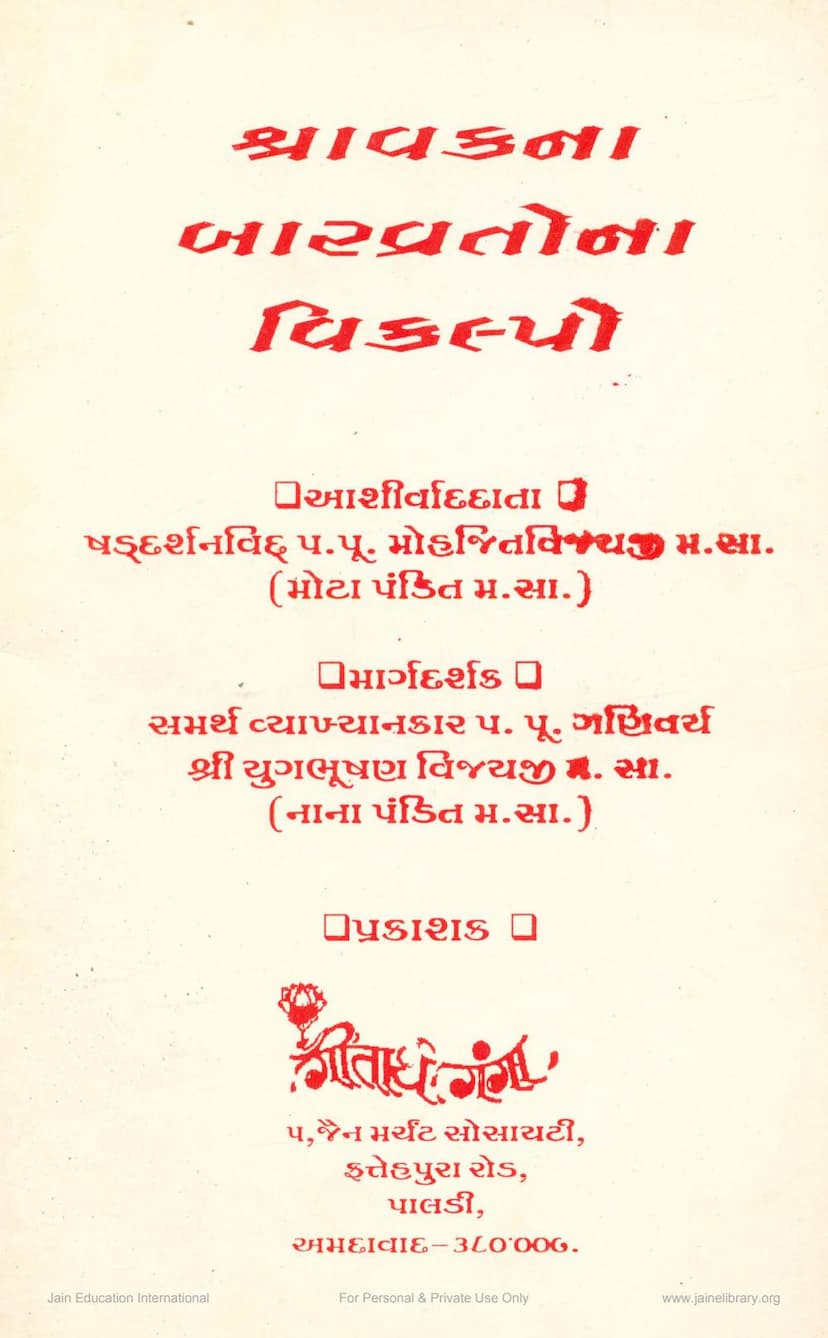Shravakna Bar Vratona Vikalpo
Added to library: September 2, 2025

Summary
This book, "Shravakna Bar Vratona Vikalpo" by Yugbhushanvijay, is a comprehensive guide to the twelve vows for lay Jain practitioners (Shravaks and Shravikas). It serves as a practical manual for understanding and observing these vows in daily life, offering variations and supplementary rules to facilitate their observance.
Here's a breakdown of the key aspects covered in the book:
Core Jain Principles and Vows:
- Foundation of Right Faith (Samyaktva): The book begins by emphasizing the importance of Samyaktva, which is the right faith in the teachings of the Tirthankaras, the omniscient beings (Arihants and Siddhas) as God, and the pure monks and nuns as Gurus. It highlights Mithyatva (false belief) as the root of suffering and encourages its abandonment.
- The Twelve Vows (Dwadasa Vratas): The primary focus is on explaining the twelve vows that form the basis of a pious Jain lay life. These vows are categorized into two main groups:
- Five Vows of Limited Restraint (Anuvratas): These are the fundamental vows, undertaken by lay followers. They are:
- Ahimsa Vrat (Non-violence): Abstaining from harming living beings, with specific guidelines and variations.
- Satya Vrat (Truthfulness): Avoiding false speech, with detailed explanations of different types of lies to abstain from.
- Asteya Vrat (Non-stealing): Not taking what is not given, with clear guidelines against various forms of theft.
- Brahmacharya Vrat (Celibacy/Chastity): Restraining sensual desires, with emphasis on faithfulness to one's spouse and avoiding illicit relations.
- Parigraha Pariman Vrat (Limited Possession): Controlling attachment to material possessions, by setting limits on wealth, property, and belongings.
- Dik Pariman Vrat (Limited Direction): Restricting movement to specific geographical areas to minimize harm to living beings.
- Bhoga Upbhoga Pariman Vrat (Limited Use of Consumables): Restraining the use of consumable items and limiting their consumption. This includes avoiding forbidden foods and drinks.
- Anartha Danda Viraman Vrat (Abstaining from Useless Activities): Avoiding activities that lead to harm or attachment, such as gambling, frivolous talk, and unnecessary entertainment.
- Four Vows of Limited Religious Observance (Gunavratas): These vows enhance the Anuvratas and are: 9. Samayika Vrat (Equanimity): Engaging in meditation and spiritual practice for a set period each day, renouncing worldly activities. 10. Deshavakashika Vrat (Temporary Renunciation of Direction): Temporarily restricting movement and activities for specific periods, like during festivals or personal vows. 11. Paushadh Vrat (Day of Religious Observance): Observing a day of fasting and religious practice, similar to a monk's observance, typically for 24 hours. 12. Atithi Samvibhag Vrat (Charity/Guest-offering): Offering food and resources to deserving monks, nuns, or needy individuals.
- Five Vows of Limited Restraint (Anuvratas): These are the fundamental vows, undertaken by lay followers. They are:
Key Features of the Book:
- "Vikalpo" (Variations/Options): The title itself indicates that the book provides various options and interpretations for observing each vow. This acknowledges that individuals have different capacities and circumstances, allowing them to choose practices that are feasible and effective for them.
- "Swarup" (Form/Essence): For each vow, the book explains its fundamental meaning and ideal form.
- "Vikalpo" (Options/Variations): Following the ideal form, it presents the specific variations or options that a practitioner can adopt.
- "Purak Niyam" (Supplementary Rules): These are supporting practices and observances that help in strengthening and sustaining the main vows. They often involve daily rituals, specific abstinences, and devotional practices.
- "Jayna" (Exceptions/Considerations): This section addresses legitimate reasons or situations where a vow might need a slight modification or exception, often due to unavoidable circumstances or a need to avoid greater harm.
- "Atichar" (Transgressions/Faults): For each vow, the book details the common transgressions or mistakes that can weaken its observance. It emphasizes the need to avoid these and seek purification if they occur.
- "Dhyeya" (Goal/Aim): The book outlines the ultimate objective behind observing each vow, connecting it to spiritual progress and the path to liberation.
- Historical and Practical Examples: The book draws heavily on the teachings and lives of exemplary Jain lay figures, most notably King Kumarpal, to illustrate the practice and efficacy of these vows. King Kumarpal's life is presented as a model of adherence to these principles, highlighting his transformation and his extensive contributions to Jainism.
- Detailed Lists: The book includes extensive lists of forbidden items (Abhakshya), activities (Karma-dan), and conditions related to food and time, providing practical guidance for daily choices.
- Emphasis on Intention and Effort: While providing detailed rules, the book implicitly stresses the importance of sincere intention, consistent effort, and the desire for spiritual growth in observing the vows.
Overall Purpose:
"Shravakna Bar Vratona Vikalpo" aims to demystify the practice of Jain vows for householders, making them accessible and adaptable to contemporary life. It acts as a guide for sincere Jain followers to lead a more ethical, disciplined, and spiritually focused life, thereby accumulating merit and moving closer to liberation. The book encourages a gradual and diligent approach, acknowledging that perfection is a journey, not an immediate attainment.